Agence France-Presse
June 22, 2024

An artist's illustration of two neutron stars merging, creating a gamma-ray burst (A. Simonnet/AFP)
A French-Chinese satellite blasted off Saturday on a hunt for the mightiest explosions in the universe, in a notable example of cooperation between a Western power and the Asian giant.
Developed by engineers from both countries, the Space Variable Objects Monitor (SVOM) will seek out gamma-ray bursts, the light from which has travelled billions of light years to reach Earth.
The 930-kilogram satellite carrying four instruments -- two French, two Chinese -- took off around 3:00 pm (0700 GMT) aboard a Chinese Long March 2-C rocket from a space base in Xichang, in the southwestern province of Sichuan, AFP journalists witnessed.
Gamma-ray bursts generally occur after the explosion of huge stars -- those more than 20 times as big as the sun -- or the fusion of compact stars.
The extremely bright cosmic beams can give off a blast of energy equivalent to over a billion billion suns.
Observing them is like "looking back in time, as the light from these objects takes a long time to reach us", Ore Gottlieb, an astrophysicist at the Flatiron Institute's Center for Astrophysics in New York, told AFP.
- 'Several mysteries' -
The rays carry traces of the gas clouds and galaxies they pass through on their journey through space -- valuable data for better understanding the history and evolution of the universe.
"SVOM has the potential to unravel several mysteries in the field of (gamma-ray bursts), including detecting the most distant GRBs in the universe, which correspond to the earliest GRBs," Gottlieb said.
The most distant bursts identified to date were produced just 630 million years after the Big Bang -- when the universe was in its infancy.
"We are... interested in gamma-ray bursts for their own sake, because they are very extreme cosmic explosions which allow us to better understand the death of certain stars," said Frederic Daigne, an astrophysicist at the Institut d'Astrophysique de Paris.
"All of this data makes it possible to test the laws of physics with phenomena that are impossible to reproduce in the laboratory on Earth."
Once analyzed, the data could help to better understand the composition of space, the dynamics of gas clouds or other galaxies.
The project stems from a partnership between the French and Chinese space agencies as well as other scientific and technical groups from both nations.
Space cooperation at this level between the West and China is fairly uncommon, especially since the United States banned all collaboration between NASA and Beijing in 2011.
- Race against time -
"US concerns on technology transfer have inhibited US allies from collaborating with the Chinese very much, but it does happen occasionally," said Jonathan McDowell, an astronomer at the Harvard-Smithsonian Center for Astrophysics in the United States.
In 2018, China and France jointly launched CFOSAT, an oceanographic satellite mainly used in marine meteorology.
And several European countries have taken part in China's Chang'e lunar exploration program.
So while SVOM is "by no means unique", it remains "significant" in the context of space collaboration between China and the West, said McDowell.
Once in orbit 625 kilometers (388 miles) above the Earth, the satellite will send its data back to observatories.
The main challenge is that gamma-ray bursts are extremely brief, leaving scientists in a race against time to gather information.
Once it detects a burst, SVOM will send an alert to a team on duty around the clock.
Within five minutes, they will have to rev up a network of telescopes on the ground that will align precisely with the axis of the burst's source to make more detailed observations.
The Conversation
June 18, 2024

Astronaut Mike Hopkins (AFP)
In the coming decade, more people will go to space than ever before as human spaceflight enters a new era. NASA, the European Space Agency and other governmental agencies are partnering to develop crewed missions beyond the Moon. At the same time, these agencies are collaborating with private companies using new technologies to drive down the price of space exploration.
Companies such as SpaceX, Blue Origin and Sierra Space have developed vehicles with reusable boosters, automated flight systems and lightweight materials to support these deep space missions. Some even have ambitions of their own to build private space stations, Moon bases or mining operations in the coming decades.
But as these technologies and partnerships rapidly make spaceflight more accessible, new challenges emerge. For one, maintaining the health and performance of an astronaut crew. My team of researchers and educators at the University of Colorado and others around the world are looking to address this issue.
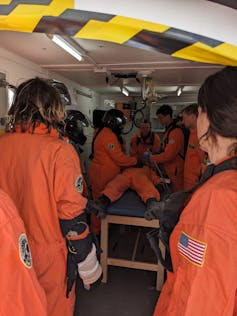
With spaceflight set to expand, astronauts will need access to medical care over longer voyages and on commercial flights. Katya Arquilla
Emerging medical challenges in space
NASA astronauts are some of the most accomplished people on the planet, and they’re some of the healthiest. Astronauts undergo extensive medical and psychological testing that in one study disqualified 26% of final-round applicants. This rigorous screening and testing process effectively limits the chance of a medical event occurring during a mission.
But as spaceflight becomes more accessible, astronaut crews on commercial missions will likely make up the majority of space travelers in the coming years. Private missions will be short and stay in a close orbit around Earth in the near term, but private crews will likely have less training and more chronic medical conditions than the professional astronauts currently living and working in space.
While experiments aboard the International Space Station have extensively studied the normal physiological changes occurring to the human system in weightlessness, there is limited to no data about how common chronic diseases such as diabetes or high blood pressure behave in the space environment.
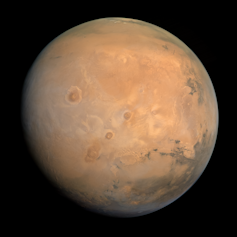
During Mars missions, astronauts will be away from Earth for long periods of time, with limited access to medical resources. CU/LASP EMM/EXI ITF/Kevin M. Gill, CC BY
This industry boom is also creating opportunities for long-duration missions to the Moon and Mars. Because of the length of missions and the distance from Earth, professional astronauts on these missions will experience prolonged weightlessness, leading to bone and muscle loss, communication delays of a few seconds up to 40 minutes, and extreme isolation for months to years at a time.
Crews must function autonomously, while being exposed to new hazards such as lunar or Martian dust. Because of the fuel required for these missions, resources will be limited to the lowest mass and volume possible.
As a result, mission planners will need to make difficult decisions to determine what supplies are truly necessary in advance, with limited or unavailable resupply opportunities for food, water and medicine. In space, for example, radiation and humidity inside a spacecraft can cause medications to deteriorate more quickly and become unavailable or even toxic to crew members.
Crews on the space station have access to a flight surgeon at Mission Control to help manage medical care in the same way telehealth is used on Earth. Crews on distant planets, however, will need to perform medical care or procedures autonomously.
In the event of a medical emergency, crews may not be able to evacuate to Earth. Unlike the space station, where medical evacuations to Earth can occur in less than 24 hours, lunar evacuations may take weeks. Evacuations from Mars may not be possible for months or even years.
Put simply, the current approaches to medical care in spaceflight will not meet the needs of future commercial and professional astronauts. Researchers will need to develop new technologies and novel training approaches to prepare future providers to treat medical conditions in space.
The current leaders in space medicine are either experts in aerospace engineering or in medicine, but rarely do experts have formal training or a complete understanding of both fields. And these disciplines often can’t speak each other’s language both literally and figuratively.
Training the next generation
To meet the evolving demands of human spaceflight, educators and universities are looking to develop a way to train specialists who understand both the limitations of the human body and the constraints of engineering design.
Some schools and hospitals, such as the University of Texas Medical Branch, have residency training programs for medical school graduates in aerospace medicine. Others, such as UCLA and Massachusetts General Hospital, have specialty training programs in space medicine, but these currently target fully trained emergency medicine physicians.
My team at the University of Colorado has created a program that integrates human physiology and engineering principles to train medical students to think like engineers.
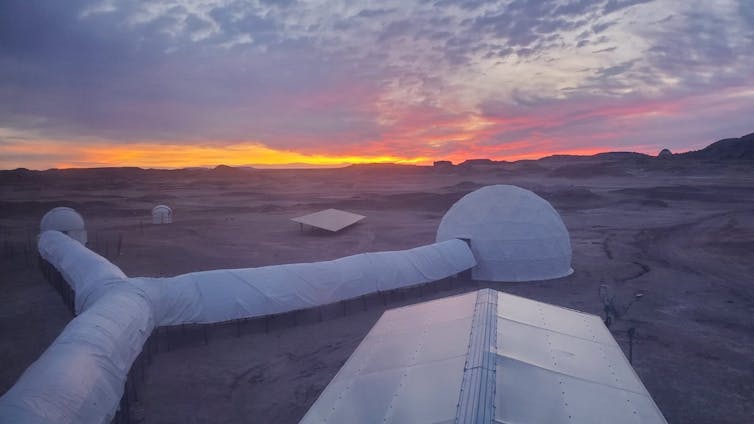
The University of Colorado brings students to the desert to simulate a lunar base. Students work together to solve simulated medical issues that might occur during a space mission. Katya Arquilla
This program aims to help students understand human health and performance in the spaceflight environment. It approaches these topics from an engineering design and constraints perspective to find solutions to the challenges astronauts will face.
One of our most popular classes is called Mars in Simulated Surface Environments. This class puts students through engineering and medical scenarios in a simulated Mars environment in the Utah desert. Students deal with the challenges of working and providing care while wearing a spacesuit and on a desolate Mars-like landscape.
The stress of the simulations can feel real to the students, and they learn to apply their combined skill sets to care for their fellow crew members.
Educational programs like these and others aim to create cross-trained specialists who understand both patient care and the procedural nature of engineering design and can merge the two, whether for space tourists in orbit or as a pioneer to the surface of another planet.
A new period of spaceflight is here, and these programs are already training experts to make space accessible and safe.

Arian Anderson, Emergency Medicine Physician, University of Colorado Anschutz Medical Campus
This article is republished from The Conversation under a Creative Commons license. Read the original article.

Say no to the DARC – stop accelerating the space arms race
By Dave Webb, Campaign for Nuclear Disarmament (CND)
Cawdor Barracks near Brawdy, about 10kms from St. Davids in a most beautiful part of Pembrokeshire, is set to be the site of another US military facility in the UK. It will include 21 receiving antenna dishes towering about 20m above the ground and 15m in diameter; 6 transmitting dishes of the same size; an operations building and perimeter and security fencing.
The RAF used Cawdor as an airfield from 1944 until it closed in 1992. It was reactivated in 1995 by the Army and became home to their electronic warfare unit. If the proposed development takes place, it will now become part of the US ‘Deep Space Advanced Radar Capability’ (DARC) system, an enhancement to US Space Surveillance Network (SSN) which includes the pyramid-shaped US ballistic missile early warning radar at Fylingdales in North Yorkshire and is controlled by the 18th Space Defence Squadron, which is a component of Space Force’s Space Delta 2 unit.
The existing data collection network can be affected by bad weather and DARC is being added to provide all-weather, 24/7 coverage of objects in geosynchronous orbit. DARC, part of the AUKUS defence agreement, will consist of three transmit/receive sites, in Texas, Australia and the UK, to detect, track and identify potential targets up to 36,000km away in geosynchronous orbit, where a lot of military surveillance and communications satellites are stationed.
And it would perform an important role in the US Space Domain Awareness (SDA) programme. SDA data is collected from an extensive collection of space-based sensors and ground-based telescopes and radars and combined with intelligence sources, produces a picture of the space environment. The US declares that SDA is needed to keep track of space debris and warn of possible collisions with satellites, but its main function is to detect, track, and identify objects in orbit, including active and inactive satellites. Thus, SDA enables the military to monitor the activities of others in space and can provide data for the targeting of anti-satellite systems.
The space component of SDA is a group of satellites called the Space-Based Space Surveillance (SBSS) system, which is maintained by the US Space Force and the National Reconnaissance Office (the US intelligence agency that builds spy satellites). Coverage of the geosynchronous orbit is also enhanced by the US Geosynchronous Space Situational Awareness Program (GSSAP) and a jointly funded spy satellite constellation called ‘Silent Barker’. The latter is a response to Russian and Chinese satellites that can manoeuvre in space and may engage with American space assets.
The war in Ukraine has reinforced how important space resources are to the military and US Space Command stated its aim of dominating and controlling space in its 1997 ‘Vision for 2020’. And domination of a region requires an ability to monitor everything that goes on there and that is why SDA is so important.
An article on DARC in the Global Times in 2021 explained how “[DARC] … is a significant escalation that has the potential to further change the direction of global military competition. The head of the Royal Air Force, Air Chief Marshal Sir Michael Wigston, has bluntly predicted the next war could be won or lost in space. The primary purpose of the US and its allies in developing DARC is obviously to prepare for winning a war and to deter China and Russia.”
The response to DARC is likely to be more countermeasures from China and Russia, accelerating the space arms race. For almost 40 years the US has either abstained or voted against UN resolutions proposed by Russia and China to prevent an arms race in space sometimes the UK joins them. In May, Brig Gen Jesse Morehouse from US Space Command was reported as saying that the US had “no choice” but to prepare for orbital combat and that the US “is ready to fight tonight in space if we have to.”
If DARC is eventually sited at Bawdy, the UK government will be ensuring that the people of Wales become an integral part of any future war in space and therefore a possible target.
- A campaign against the radar – “Parc Against DARC” – has been now been launched. More details can be found here.
- Dave Webb is the Former Chair of the Campaign for Nuclear Disarmament. You can follow the CND on Facebook, Instagram and Twitter/X.
- If you support Labour Outlook’s work amplifying the voices of left movements and struggles here and internationally, please consider becoming a supporter on Patreon.
‘We think we have put together a dream team,’ said organizers of the event, which hopes to reconcile quantum theory and cosmology.
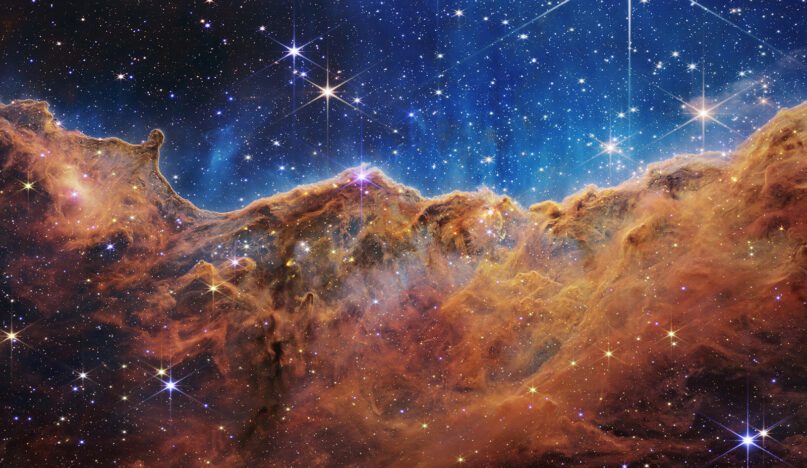
The Carina Nebula is one of the largest and brightest nebulae in the sky, located approximately 7,600 light-years away in the southern constellation Carina. Nebulae are stellar nurseries where stars form. The Carina Nebula is home to many massive stars, several times larger than the sun. (Image credits: NASA, ESA, CSA and STScI)
June 11, 2024
By Claire Giangravé
VATICAN CITY (RNS) — Renowned physicists, including two Nobel Prize winners, will gather at the Vatican Observatory near Rome next week to ponder the unresolved mysteries of the cosmos and to honor the legacy of Georges Lemaître, the priest who first theorized the Big Bang and the expansion of the universe.
“We think we have put together a dream team that we vehemently hope will lead to some innovative thinking,” said Fabio Scardigli, a theoretic physicist from the Polytechnic Institute of Milan and one of the organizers of the event, during a news conference Tuesday (June 11) presenting the meeting.
The workshop June 16-21 will bring together experts from two sides of the scientific community: those who study cosmology and the theory of relativity, and those physicists who study quantum theory. Organizers of the event hope that the gathering will foster dialogue about these two different and at times irreconcilable theories.
“Among the goals of this conference is to take small steps, through discussion and debate, to reconcile these two theoretic constructions of the 20th century,” Scardigli said.
The Vatican Observatory, called Specola Vaticana, was established in 1891 by Pope Leo XIII to promote dialogue between faith and science. Forty physicists will participate at the gathering, including Adam Riess, who was awarded a Nobel Prize for proving that the expansion of the universe is accelerating, and Roger Penrose, who won the Nobel Prize for his groundbreaking study of black holes.
Participants also include Andrei Linde and Joseph Silk, who revolutionized cosmology through their studies on the first moments of the universe; Wendy Freedman, known for her groundbreaking research on the expansion of the universe; Licia Verde, an expert on dark matter and energy; Cumrun Vafa, who is considered a trailblazer for his studies on geometry and quantum physics; and Edward Witten, best known for his pioneering contributions to string theory.

The Vatican Observatory sits atop Castel Gandolfo, south of Rome. (Photo by H. Raab/Wikipedia/Creative Commons)
Participants are scheduled to meet with Pope Francis at the Vatican on June 19, and organizers believe the pope will deliver a speech.
While the Vatican might strike some as an unlikely partner for the advancement of science, the Catholic Church has played a key role in the field of physics throughout history. “I was a scientist for 20 years before I joined the Jesuits, and the most common reaction from fellow scientists was a freedom from them to tell me about the churches they belong to,” said Brother Guy Consolmagno, the director of the Vatican Observatory, during the news conference.
“In the field of cosmology, where we are so much aware of what we do not know, there is an openness to reflect on why there is something instead of nothing,” Consolmagno said, adding that “in the academic world you find more atheists in the literature department than among physicists.”
The verdant setting of Castel Gandolfo, where the Specola resides, offers a neutral ground for scientists to discuss theories, present their research and studies and butt heads on the cosmos’s conundrums, organizers said.
“It’s a place where scientists, researchers and academics can feel free to speak unencumbered by academic structures where they are bound to one type of theoretical current or another,” said the Rev. Gabriele Gionti, the vice director at the observatory.
In 2022, Gionti and the Rev. Matteo Galaverni, a priest in the Diocese of Reggio Emilia-Guastalla in northern Italy, theorized a new way to study gravity after the Big Bang. Their study was highly regarded in the scientific community and published in the prestigious Physical Review D journal. Gionti’s life work has been to attempt to reconcile quantum physics and cosmology, following in the footsteps of another influential physicist and priest: Lemaître.
RELATED: Pope recreates the 2014 Mideast peace prayer in Vatican Gardens to beg for an end to Gaza conflict
Born in Belgium in 1894, Lemaître was an innovator in the field of physics and theology, having joined the Priestly Fraternity of the Friends of Jesus. In 1927, he proved that the universe was expanding before Edwin Hubble, which led Lemaître to theorize the existence of “the primeval atom,” when the universe must have been compressed before the Big Bang.
That same year, the first theories on quantum physics emerged, challenging our understanding of the universe. Lemaître, whose studies outlined what would later be described as quantum gravity, was a friend of Albert Einstein, despite Einstein’s opposition to the theory of an expanding universe and quantum physics. Recognition of Lemaître’s lasting impact has been growing recently, with the International Astronomical Union voting in 2018 that the Hubble Law, which describes the speed at which galaxies are moving away from Earth, should be renamed the Hubble-Lemaître Law.
Quoting St. John Paul II, Consolmagno described faith and reason as two wings leading toward the truth. “Truth is the goal,” he said, “and for those of us who believe that God is the truth, exploring the truth leads us closer to God.”
The Conversation
June 14, 2024

The Universe (Shutterstock)
Astronomers, maybe more than anyone, appreciate what an island of perfection our Earth is. Our orbit may put us at a perfect distance from the sun for life to flourish, but it is too small to easily help astronomers determine how big the universe is.
Late Renaissance scholar Nicolaus Copernicus suggested that the Earth orbits the sun in 1543, but it took 300 years to prove it.
In 1838, a nearby star appeared to wobble because our viewpoint on Earth was moving due to our planet being in orbit around the sun. Such apparent motion is called “parallax.”
We can use only indirect means to find out how far away any external galaxy lies. Recent space missions allow us to see the apparent motion of billions of stars, but that still covers only a corner of our huge galaxy.
Until 100 years ago, it was greatly disputed whether other galaxies even existed, or if the Milky Way was the whole universe.
Explaining the universe
The German philosopher Immanuel Kant published Universal Natural History and Theory of the Heavens in 1755, speculating that certain small dim patches in the sky might be analogues of our Milky Way. These “nebulae” (the word means cloud) were usually viewed as nuisances, confusing comet hunters. Only with the development of large telescopes in the early 19th century were some of them seen to have a spiral form.
Seeking, much like Kant, a mechanical explanation for the universe and the formation of the solar system, the French mathematical astronomer Pierre Simon Laplace published Exposition du Système du Monde in 1796. Laplace survived the French Revolution to become a government minister under Napoleon, and eventually minor nobility when royalty returned to France: such survival skills enabled him to publish several editions of his influential book.
In it, Laplace describes the collapse of a gas cloud to form a star and solar system, a process for which we now have direct evidence. It was perhaps natural that the spiraling in of material to form a star became a preferred theory to explain the spiral nebulae.
There was no way to tell whether these spirals were new stars forming or Kant’s “island universes” until Edwin Hubble observed a star not wobbling, but instead varying in brightness in a nearby galaxy; Hubble presented his findings in January 1925.
Distance and luminosity
The Milky Way has several neighbouring galaxies. The Andromeda spiral (M31) resembles it, but the smaller, irregular pair of dwarf galaxies known as the Magellanic Clouds, visible only from southerly latitudes, are closer. Due to their huge distance from us, no outside galaxy can be seen to wobble (have parallax) due to Earth’s motion and another method is needed to find their distances.
Certain stars vary in brightness, and those called Cepheids are useful for indicating distance due to a relation between how much light they give off and their period of variation (in days).
This “period-luminosity” relation for Cepheids was discovered by pioneering astronomer Henrietta Leavitt using the Magellanic Clouds.
Calibration of Cepheids for use in any galaxy was done by American scientist Harlow Shapley, who had become famous by showing that the sun was not in the centre of the Milky Way. Ironically, Shapley did not believe that external galaxies existed.
A lesser-known figure, American astronomer Vesto Slipher, worked at Lowell Observatory in Flagstaff, Ariz., built by the millionaire astronomer Percival Lowell to further his ideas about life on Mars and the presence of a then-unknown ninth planet (Pluto, discovered in 1930 before being demoted in 2006).
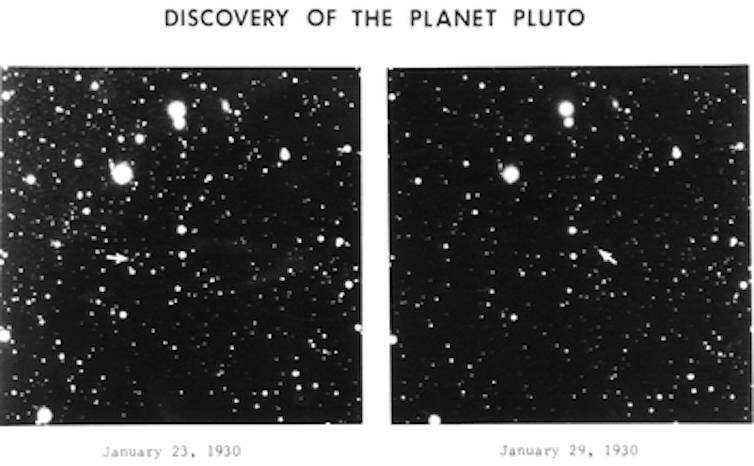
The original plates from Clyde Tombaugh’s discovery of Pluto in 1930.
Slipher, working with a small telescope equipped with ingenious spectroscopes, had found that spiral nebulae move at high speeds, mostly away from us — which is usually regarded as Hubble’s second breakthrough. Slipher also found that they spin at high speed, which made such an impression that some leading astronomers claimed to see the motion (over years), proving the spiral nebulae to be nearby.
It took the world’s largest telescope, painstakingly used by Edwin Hubble, to resolve the question.
Measuring distance
Mount Wilson looms about 1.7 km above the Los Angeles basin. Before light pollution from the city became excessive, the mountainside was a suitable location for the Hooker telescope, finished in 1917. It was a powerful tool for the young Hubble, hired at the Mount Wilson Observatory in 1919 after serving in the military.
The apparent large size of the Andromeda nebula — many times larger than the moon if photographed to show the faint outer regions — meant it was nearby and might resolve the spiral nebula question if studied properly. Hubble initially studied novae — exploding stars that can be picked out due to their brightness.
Hubble had to work past the confusion that in 1885, Andromeda had hosted a supernova, something so unfamiliar at the time that it was thought to prove the Laplace collapse theory since the spiral seemed to have formed a new star near its centre. To make matters worse, among novae there is a lot of variation in brightness, so they are not good indicators of distance
Nevertheless, Hubble monitored them systematically. On a photograph taken in late 1923, he realized that one of his “novae” was fading in and out, and was in fact a Cepheid variable star, able to be used to determine distances accurately.
In 1924, Hubble found many more Cepheids, all able to have their actual luminosity determined. Knowing this and how faint they appeared as seen from Earth, Hubble was able to demonstrate that the Andromeda nebula was roughly two million light years away: a neighbouring spiral galaxy. Previously thought to be part of our own galaxy, Andromeda was in fact about one thousand times further away.
The new perception of the size of the universe allowed Hubble, several years later, to go further and propose Hubble’s Law, a theory of the expansion of the universe, yet later shown to have begun with the Big Bang 13.6 billion years ago.
But, at least in astronomy, 1924 was the year that the universe exploded.

Martin Connors, Professor of Space Science and Physics, Athabasca University
This article is republished from The Conversation under a Creative Commons license. Read the original article.
No comments:
Post a Comment